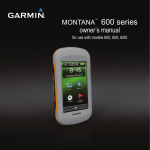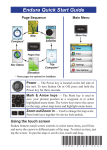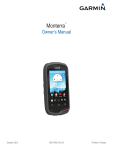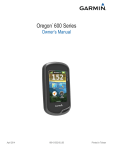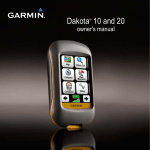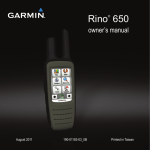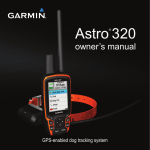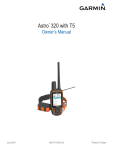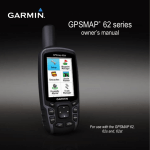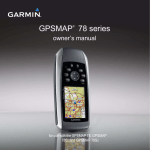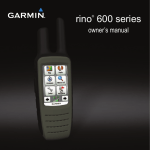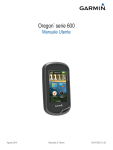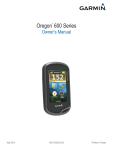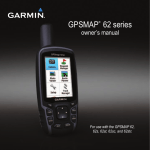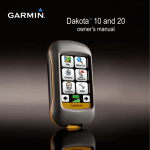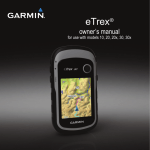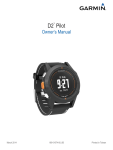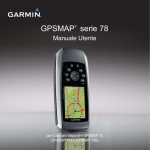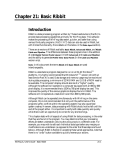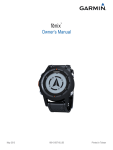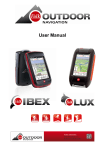Download "user manual"
Transcript
montana series
600, 650, 650t
owner’s manual
™
© 2010 Garmin Ltd. or its subsidiaries
All rights reserved. Except as expressly provided herein, no part of this manual may be reproduced, copied,
transmitted, disseminated, downloaded or stored in any storage medium, for any purpose without the express
prior written consent of Garmin. Garmin hereby grants permission to download a single copy of this manual
onto a hard drive or other electronic storage medium to be viewed and to print one copy of this manual or of
any revision hereto, provided that such electronic or printed copy of this manual must contain the complete
text of this copyright notice and provided further that any unauthorized commercial distribution of this manual
or any revision hereto is strictly prohibited.
Information in this document is subject to change without notice. Garmin reserves the right to change
or improve its products and to make changes in the content without obligation to notify any person or
organization of such changes or improvements. Visit the Garmin Web site (www.garmin.com) for current
updates and supplemental information concerning the use and operation of this and other Garmin products.
Garmin®, BlueChart®, and City Navigator® are trademarks of Garmin Ltd. or its subsidiaries, registered in the
USA and other countries. Montana™, HomePort™, BaseCamp™, ANT™, and ANT+™ are trademarks of Garmin
Ltd. or its subsidiaries. These trademarks may not be used without the express permission of Garmin.
Windows® is a registered trademark of Microsoft Corporation in the United States and/or other countries.
Mac® is a registered trademarks of Apple Computer, Inc. microSD™ is a trademark of SD-3C, LLC.. Other
trademarks and trade names are those of their respective owners.
Table of Contents
Getting Started.........................1
Device Overview............................1
Battery Information.........................2
Turning the Device On or Off..........3
Satellite Signals..............................3
Registering Your Device.................3
About the Main Menu.....................3
Using the Touchscreen...................4
Rotating the Screen........................4
Turning On the Backlight................4
Profiles...........................................5
Waypoints, Routes, and
Tracks.......................................6
Waypoints.......................................6
Using Sight ‘N Go...........................7
Routes............................................7
Where To? Menu............................9
Tracks...........................................10
Adventures...................................12
Navigation..............................13
Montana 600 Series Owner’s Manual
Starting Navigation.......................13
Map..............................................13
Compass......................................15
Elevation Plot...............................16
Trip Computer...............................17
Camera and Photos...............18
Taking a Photo..............................18
Viewing Photos.............................18
Geocaches.............................20
Downloading Geocaches.............20
Filtering the Geocache List...........20
Navigating to a Geocache............21
Logging the Attempt.....................21
chirp..............................................22
Applications...........................23
Using the 3D View........................23
About Sharing Data......................23
Setting a Proximity Alarm.............24
Calculating the Size of an Area....24
Using the Calculator.....................24
Viewing the Calendar and
c
Table of Contents
Almanacs...................................24
Setting an Alarm...........................25
Opening the Stopwatch................25
Satellite.........................................25
Customizing Your Device.....27
Customizing the Main Menu and
Application Drawer.....................27
Creating Shortcuts........................27
Customizing Specific Pages.........27
Creating a Custom Profile............28
System Settings...........................28
Display Settings............................29
Appearance Settings....................30
Setting the Device Tones..............31
Map Settings................................31
Camera Settings...........................32
Tracks Settings.............................32
Changing the Units of Measure....33
Time Settings................................33
Position Format Settings..............33
Heading Settings..........................33
Altimeter Settings.........................34
iv
Geocache Settings.......................35
Routing Settings...........................35
Marine Map Settings....................36
Fitness..........................................37
Resetting Data..............................37
Device Information................38
Updating the Software..................38
Viewing Device Information..........38
Specifications...............................38
About the Batteries.......................38
Caring for the Device....................39
Data Management........................40
Appendix................................43
Optional Accessories....................43
Optional Fitness Accessories.......43
Data Field Options........................44
Troubleshooting............................50
Index.......................................52
Montana 600 Series Owner’s Manual
Getting Started
Getting Started
Device Overview
warning
See the Important Safety and Product
Information guide in the product
box for product warnings and other
important information.
➌
When using your device the first time,
you should complete these tasks to set
up the device and get to know the basic
features.
1.
2.
3.
4.
5.
6.
7.
8.
9.
Install the batteries (page 2).
Turn on the device (page 3).
Register the device (page 3).
Acquire satellites (page 3).
Calibrate the compass (page 15).
Mark a waypoint (page 6).
Create a route (page 7).
Record a track (page 10).
Navigate to a destination (page 13).
Montana 600 Series Owner’s Manual
➊
➋
➎
➐
➍
➏
➑
➊ Camera lens (650 and 650t only)
➋
Power key
➌ microSD™ card slot (page 40)
➍ Auto mount power connector
➎ Headphone jack (page 14)
➏ Mini-USB port (under weather cap)
➐ Battery cover D-ring
➑ MCX port for GPS antenna (under
weather cap)
1
Getting Started
Battery Information
The device operates on the included
lithium-ion battery pack or three AA
batteries.
Installing the Battery Pack
1. Turn the D-ring counter-clockwise,
and pull up to remove the cover.
2. Locate the battery that came in the
product box.
3. Align the metal contacts on the
end of the battery ➊ with the
metal contacts ➋ in the battery
compartment.
5. Replace the battery cover, and turn
the D-ring clockwise.
Installing AA Batteries
Instead of the lithium-ion battery pack,
you can use alkaline, NiMH, or lithium
batteries. This is especially handy
when you are on the trail and cannot
charge the lithium-ion battery pack.
Use NiMH or lithium batteries for best
results.
1. Turn the D-ring counter-clockwise,
and pull up to remove the cover.
2. Insert three AA batteries, observing
polarity.
➊
➋
4. Insert the battery.
2
Montana 600 Series Owner’s Manual
Getting Started
3. Replace the battery cover, and turn
the D-ring clockwise.
4. Update the battery type in the
system settings (page 39).
Registering Your Device
Turning the Device On or
Off
About the Main Menu
Hold
.
Satellite Signals
After the device is turned on, it begins
acquiring satellite signals. The device
may need a clear view of the sky to
acquire satellite signals. When at least
one of the
bars is green, your
device has acquired satellite signals.
The time and date are set automatically
based on the GPS position. To adjust
the time settings, see page 33.
For more information about GPS, go to
www.garmin.com/aboutGPS.
Montana 600 Series Owner’s Manual
• Go to http://my.garmin.com.
• Keep the original sales receipt, or a
photocopy, in a safe place.
➊
➋
➌
➍
➊ Status bar
➋ Current time and date
➌ Application icons
➍ Application drawer containing
more application icons
3
Getting Started
Using the Touchscreen
• Select to open the application
drawer.
• Select to close the page and
return to the previous page.
• Select to return to the previous
page.
• Select to save changes and close
the page.
• Select and to scroll.
• Select to open a menu.
• Select to search by name.
Locking the Screen
Lock the screen to prevent inadvertent
screen touches.
1. Press .
2. Select {lock icon}.
Unlocking the Screen
1. Press .
2. Select {unlock icon}.
4
Rotating the Screen
To lock the screen orientation, see
page 29.
Rotate your device to view in
horizontal (landscape) or vertical
(portrait) mode.
Turning On the Backlight
The backlight will turn off after a
period of inactivity. To change the
backlight timeout, see page 29.
Select an option:
• Press .
• Touch the screen.
Alerts and messages also activate the
Montana 600 Series Owner’s Manual
Getting Started
backlight.
Adjusting the Backlight
Brightness
1. While the device is on, press .
2. Use the slider bar to adjust the
brightness level.
Profiles
Profiles are a collection of settings that
optimize your device based on how
you are using it. For example, marine
use and recreational use.
When you are using a profile and you
change settings such as data fields or
units of measurement, the changes
are saved automatically as part of the
profile.
Selecting a Profile
1. Select > Profile Change.
2. Select a profile.
Montana 600 Series Owner’s Manual
5
Waypoints, Routes, and Tracks
Waypoints, Routes,
and Tracks
Waypoints
Waypoints are locations you record and
store in the device.
Creating a Waypoint
Select Mark Waypoint > Save.
Finding a Waypoint
1. Select Where To? > Waypoints.
3. Select a waypoint.
Editing a Waypoint
Before you can edit a waypoint, you
must create a waypoint.
1.
2.
3.
4.
5.
6
Select > Waypoint Manager.
Select a waypoint.
Select an item to edit.
Enter the new information.
Select .
Deleting a Waypoint
1. Select > Waypoint Manager.
2. Select a waypoint.
3. Select > Delete.
Increasing the Accuracy of a
Waypoint Location
Waypoint Averaging allows you to
increase the accuracy of a waypoint
location by collecting multiple samples
of the waypoint location.
1.
2.
3.
4.
5.
Select > Waypoint Averaging.
Select a waypoint.
Move to the location.
Select Start.
When the Sample Confidence status
bar reaches 100%, select Save.
For best results, collect four to
eight samples for the waypoint,
waiting at least 90 minutes between
samples.
Montana 600 Series Owner’s Manual
Waypoints, Routes, and Tracks
Projecting a Waypoint
1. Select > Sight ‘N Go.
2. Point the device at an object or in
the direction of a location.
3. Select Lock Direction > Set
Course.
4. Select a unit of measure.
5. Enter the distance to the object, and
select .
6. Select Save.
Using Sight ‘N Go
You can point the device at an object in
the distance, such as a lighthouse, lock
in the direction, and then navigate to
the object.
1. Select > Sight ‘N Go.
2. Point the device at an object.
3. Select Lock Direction > Set
Course.
Montana 600 Series Owner’s Manual
Routes
A route is a sequence of waypoints that
leads you to your final destination.
Creating a Route
1. Select > Route Planner >
Create Route > Select First Point.
2. Select a category.
3. Select the first point in the route.
4. Select Use.
5. Select Select Next Point.
6. Repeat steps 2–5 until the route is
complete.
A route must contain at least two
points.
7. Select to save the route.
Editing the Name of a Route
1. Select > Route Planner.
2. Select a route.
3. Select Change Name.
4. Enter the new name.
7
Waypoints, Routes, and Tracks
5. Select
.
Editing a Route
1. Select > Route Planner.
2. Select a route.
3. Select Edit Route.
4. Select a point.
5. Select an option:
• To view the point on the map,
select Review.
• To change the order of the point
on the route, select Move Down
or Move Up.
• To add an additional point on
the route, select Insert.
The additional point is inserted
before the point you are editing.
• To remove the point from the
route, select Remove.
6. Select to save the route.
8
Viewing a Route on the Map
1. Select > Route Planner.
2. Select a route.
3. Select View Map.
Deleting a Route
1. Select > Route Planner.
2. Select a route.
3. Select Delete Route.
Viewing the Active Route
1. While navigating a route, select
> Active Route.
2. Select a point in the route to view
additional details.
Reversing a Route
1. Select > Route Planner.
2. Select a route.
3. Select Reverse Route.
Montana 600 Series Owner’s Manual
Waypoints, Routes, and Tracks
Where To? Menu
Finding a Location Near
Another Location
1. Select Where To? > .
2. Select an option.
3. If necessary, select a location.
Additional Maps
You can use additional maps in the
device, such as BirdsEye™ satellite
imagery, BlueChart® g2, and City
Navigator® detailed maps. Detailed
maps may contain additional points of
interest, such as restaurants or marine
services. For more information, go to
http://buy.garmin.com or contact your
Garmin dealer.
Finding a Point of Interest
Depending on the maps loaded on your
device, you can search for various
points of interest (POIs), such as
restaurants, hotels, and auto services.
You can use the Where To? menu to
find a destination to navigate to. Not all
Where To? categories are available in
all areas and maps.
Finding a Location by Name
1. Select Where To?.
2. Select a category.
3. Select .
4. Enter the name or part of the name.
5. Select .
Montana 600 Series Owner’s Manual
1. Select Where To?.
2. Select an option to view POIs near
your current location:
• Select All POIs.
• Select a POI category.
3. If necessary, select to narrow
your search.
4. Select an item from the list.
9
Waypoints, Routes, and Tracks
Finding an Address
You can use optional City Navigator®
maps to search for addresses.
1. Select Where To? > Addresses.
2. Enter the country.
3. Enter the city or postal code.
NOTE: Not all map data provides
postal code searching.
4. Select the city.
5. Enter the house number.
6. Enter the street.
Tracks
A track is a recording of your path.
The track log contains information
about points along the recorded path,
including time, location, and elevation
for each point.
Recording Track Logs
1. Select > Setup > Tracks >
Track Log.
10
2. Select Record, Do Not Show or
Record, Show On Map.
If you select Record, Show On
Map, a line on the map indicates
your track.
3. Select Record Method.
4. Select an option:
• To record tracks at a variable
rate to create an optimum
representation of your tracks,
select Auto.
• To record tracks at a specified
distance, select Distance.
• To record tracks at a specified
time, select Time.
5. Select Interval.
6. Select an option to record tracks
more or less often.
NOTE: Using the Most Often
interval provides the most track
detail and fills up the device
memory quicker.
Montana 600 Series Owner’s Manual
Waypoints, Routes, and Tracks
Saving the Current Track
The track being recorded is called the
current track.
1. Select > Track Manager >
Current Track.
2. Select what you want to save:
• To save the entire active track,
select Save Track.
• To select a portion of the current
track to save, select Save
Portion, and select a portion.
Viewing a Track on the Map
1. Select > Track Manager.
2. Select a track.
3. Select View Map.
The beginning and the end of the
track are marked by a flag.
Viewing the Elevation Plot of a
Track
1. Select > Track Manager.
2. Select a track.
Montana 600 Series Owner’s Manual
3. Select Elevation Plot.
Saving a Location on a Track
1. Select > Track Manager.
2. Select a track.
3. Select View Map.
4. Select a location on the track.
5. Select the information bar on the
top of the screen.
6. Select .
7. Select OK.
Changing the Track Color
1. Select > Track Manager.
2. Select a track.
3. Select Set Color.
4. Select a color.
Clearing the Current Track
Select > Setup > Reset > Clear
Current Track > Yes.
Deleting a Track
1. Select > Track Manager.
11
Waypoints, Routes, and Tracks
2. Select a track.
3. Select Delete > Yes.
Adventures
What are adventures?
Creating an Adventure
1. Select > Setup > Adventures >
Create Adventure > Add Item.
2. Select an item.
3. Select Use.
No what?
12
Montana 600 Series Owner’s Manual
Navigation
You can navigate a route, a track, to a
waypoint, to a geocache, to a photo,
or to any saved location in the device.
You can use the map or the compass to
navigate to your destination.
Starting Navigation
You can begin navigating to a
destination by selecting Go. xx
1.
2.
3.
4.
Select Where To?.
Select a category.
Select a location.
Select Go.
Starting a Trackback
You can navigate back to the beginning
of a track. This can be helpful when
finding your way back to camp or the
trail head.
1. Select > Track Manager >
Current Track > View Map.
Montana 600 Series Owner’s Manual
Navigation
2. Select Trackback.
Starting Navigation to Man
Overboard Location
Select > Man Overboard >
Start.
Stopping Navigation
Select > Where To? > Stop
Navigation.
Map
The position icon represents your
location on the map. As you travel, the
position icon moves and leaves a track
log (page 10). Waypoint names and
symbols also appear on the map.
For information about customizing
the map settings, see page 31. For
information about customizing the map
dashboard and data fields, see page 27.
Navigating with the Map
1. Begin navigation (page 13).
13
Navigation
The map page opens with your
route marked with a magenta line.
2. Use the magenta line to navigate to
your destination.
Browsing the Map
1. Select Map.
2. Drag the map to view different
areas.
3. Select and to zoom in and
out of the map.
4. Select the information bar on
the top of the screen to view
information about the selected
location (represented by a pin).
Measuring Distance
You can use the map to measure the
distance from a point to the current
location.
1. Select Map >
Distance.
14
> Measure
The device automatically begins
measuring from your current
location.
3. Select the point to measure to.
The distance appears at the top of
the page.
>
To stop measuring, select Map >
Stop Measuring.
Using the Map in Automobile
Mode
Caution
You can permanently damage your ears
and lose hearing if you listen to the
device, earbuds, or headphones at high
volume. Limit the amount of time you
listen at high volume. If you experience
ringing in your ears or muffled speech,
stop listening and have your hearing
checked.
You can follow a turn-by turn, road
route to your destination when using
City Navigator maps. Voice prompts
Montana 600 Series Owner’s Manual
Navigation
will sound as you follow the route.
Connect headphones or an audio lineout cable to the headphone jack to hear
voice prompts.
Compass
The device has a 3-axis compass. You
can use a bearing pointer or a course
pointer to navigate to your destination.
Calibrating the Compass
Notice
Calibrate the electronic compass
outdoors. Do not stand near objects that
influence magnetic fields, such as cars,
buildings, or overhead power lines.
You should calibrate the compass after
moving long distances, experiencing
temperature changes, or changing the
batteries.
1. Select Compass >
Compass > Start.
> Calibrate
Montana 600 Series Owner’s Manual
3. Follow the on-screen instructions.
Navigating with the Bearing
Pointer
When navigating to a destination,
the bearing pointer points to your
destination, regardless of the direction
you are moving.
1. Begin navigation to a destination
(page 13).
2. Select Compass.
3. Hold the device level.
4. Use the bearing or course pointer to
navigate to your destination.
• When the bearing pointer points
toward the top of the electronic
compass, you are traveling
directly toward your destination.
• If the bearing pointer is not
pointing toward the top of the
compass, turn until the arrow is
pointing up.
15
Navigation
Navigating with the Course
Pointer
This is most useful if you are
navigating on water or where there
are no major obstacles in your path. It
also helps you avoid hazards to either
side of the course, such as shoals or
submerged rocks.
Before you can navigate with the
course pointer, you must select the
Course (CDI) for the pointer (page 34).
1. Begin navigation to a destination
(page 13).
2. Select Compass.
3. Hold the device level.
➋
➍
16
➌
➊
• The course pointer ➊
indicates your relationship to
a course line ➋ leading to the
destination.
• The course pointer provides an
indication of drift (right or left)
according to the scale ➌.
• The scale refers to the distance
between dots on the course
deviation indicator ➍.
• The course line to your
destination is based on your
original starting point.
4. Move back to the “course line to
destination” to compensate for
deviation and to get back on course.
Elevation Plot
By default, the Elevation Plot displays
the elevation for an elapsed time.
For information on customizing the
elevation plot, see page 34.
Montana 600 Series Owner’s Manual
Navigation
3. Follow the on-screen instructions.
Your current elevation ➊ and the
rate of your ascent or descent ➋
appear.
➍
Trip Computer
The trip computer displays your current
speed, average speed, maximum
speed, trip odometer, and other helpful
statistics.
To customize the trip computer, see
page 27.
➌
➋
Resetting the Trip Data
For accurate information, reset the trip
information before beginning a trip.
➊
Adjusting the Scale
Calibrating the Barometric
Altimeter
You can manually calibrate the
barometric altimeter if you know
the correct elevation or the correct
pressure.
1. From the elevation plot, select
2. Select Calibrate Altimeter.
Montana 600 Series Owner’s Manual
Select > Trip Computer >
> Reset Trip Data > Yes.
All of the trip computer values are
set to zero.
.
17
Camera and Photos
Camera and Photos
You can take photo with the Montana
650 and 650t. The location is saved
with the photo. You can navigate to the
location like a waypoint.
Taking a Photo
Focus image: hold camera button
Cancel photo: Slide off camera button
Capture photo: Release camera button
1. Select > Camera.
2. Turn the device horizontally or
vertically to change the orientation
of the picture.
3. If necessary, select to enable or
to disable low-light mode.
4. If necessary, select + or - to adjust
the zoom on the camera.
18
5. To manually focus the camera, hold
until the white focus frame
turns green.
6. Release
to take the picture.
to automatically
NOTE: Select
focus the camera and take a picture.
NOTE: To view the last picture taken,
select {icon} at the bottom of the
screen.
Viewing Photos
You can view photos you have taken
with the camera (page 18) and photos
you have transferred to the device
(page 42).
1. Select > Photo Viewer.
2. Select and to view all the
pictures.
3. Select a picture to see a larger view
of it.
Montana 600 Series Owner’s Manual
Camera and Photos
Viewing a Slideshow
1. Select > Photo Viewer.
2. Select a picture.
3. Select > View Slideshow.
The device will briefly display each
picture in the device.
2. Select a picture.
3. Select > Set as Wallpaper.
Sorting Photos
1. Select > Photo Viewer.
2. Select .
3. Select an option: Most Recently,
Near a Location, or On a Specific
Date.
Starting Navigation to a Photo
1. Select > Photo Viewer.
2. Select a picture.
3. Select > View Information >
Go.
Viewing the Location of the
Photo
1. Select > Photo Viewer.
2. Select a picture.
3. Select > View Map.
Setting the Photo as the
Wallpaper
1. Select > Photo Viewer.
Montana 600 Series Owner’s Manual
Deleting a Photo
1. Select > Photo Viewer.
2. Select a picture.
3. Select > Delete Photo > Yes.
Uploading and Downloading
Pictures Need more info!
1. Go to http://my.garmin.com, and
log into your myGarmin account.
2. Connect your device to a computer
(page 41).
3. Follow the on-screen directions to
upload or download pictures.
19
Geocaches
Geocaches
Geocaching is a type of treasure
hunting, in which geocachers seek
hidden treasures using GPS coordinates
posted on the Internet by those hiding
the geocache.
Downloading Geocaches
1. Register your device (page 3).
2. Connect your device to your
computer (page 41).
3. Go to www.garmin.com/products/
communicator.
4. Download the Garmin
Communicator plug-in.
5. Go to www.OpenGeocache.com.
6. Follow the on-screen instructions
to download geocaches to your
device.
20
Filtering the Geocache
List
1. Select > Geocaches > Quick
Filter.
2. Select items to filter.
3. Select an option:
• To apply the filter to the
geocache list, select Search.
• To save the filter, select .
Creating a Custom Geocache
Filter
1. Select > Setup > Geocaches >
Filter Setup > Create Filter.
2. Select items to filter.
3. Select an option:
• To apply the filter to the
geocache list, select Search.
• To save the filter, select .
Montana 600 Series Owner’s Manual
Geocaches
After it is saved, the filter is
automatically named. You can
access the custom filter from the
geocaches list.
Editing a Custom Geocache
Filter
1. Select > Setup > Geocaches >
Filter Setup.
2. Select a filter.
3. Select an item to edit.
Navigating to a Geocache
1.
2.
3.
4.
5.
Select > Geocaches.
Select Find a Geocache.
Select a geocache.
Select Go.
Use the map or compass to navigate
to the location.
Montana 600 Series Owner’s Manual
Logging the Attempt
After you have attempted to find a
geocache, you can log your results.
1. Select > Geocaches > Log
Attempt.
2. Select Found, Did Not Find,
Needs Repair, or Unattempted.
3. Select an option:
• To begin navigation to a
geocache nearest you, select
Find Next Closest.
• To end the logging, select Done.
• To enter a comment about
the hunt or cache, select Edit
Comment, enter a comments,
and select .
• To rate the geocache, select
Rate Geocache, and select an
item to rate.
21
How
know
obvio
page
cache
Geocaches
chirp
A chirp is a small accessory that you
can program and leave in a geocache.
Only the owner of the chirp can
program a chirp accessory. For more
information about programming a
chirp, see the chirp Owner's Manual at
www.garmin.com.
Anyone can navigate to a chirp in a
geocache.
Enable chirp Searching
1. Select > Setup > Geocaches.
2. Select Chirp Searching > On.
Finding a Geocache with a
chirp
1. Select > Geocaches > Show
chirp™ Details > .
2. Select Chirp Searching > On.
22
Montana 600 Series Owner’s Manual
Applications
Using the 3D View
1. Select
> 3D View.
Applications
• To pan the 3D map backward,
select .
• To rotate the view to the left,
select .
• To rotate the view to the right,
select .
About Sharing Data
Your device can send or receive data
when connected to another compatible
device. You can share waypoints,
geocaches, routes, and tracks.
2. Select an option:
• To increase the angle of
elevation, select .
• To decrease the angle of
elevation, select .
• To pan the 3D map forward,
select .
Montana 600 Series Owner’s Manual
Sending and Receiving Data
Wirelessly
Before you can share data wirelessly,
you must be within 10 feet (3 m) of the
compatible Garmin device.
1. Select > Share Wirelessly.
2. Select Send or Receive.
3. Follow the on-screen instructions.
23
Applications
Setting a Proximity Alarm
Using the Calculator
1. Select > Proximity Alarms.
2. Select Create Alarm.
3. Select a category.
4. Select a location.
5. Select Use.
6. Enter a radius.
7. Select .
When you enter a proximity alarm
area, the device will sound a tone.
1. Select > Calculator.
2. Complete an action:
• Use the standard calculator.
• Select > Scientific to use the
scientific calculator functions.
• Select > Degrees to calculate
degrees.
Proximity alarms alert you when you
are approaching a predetermined area.
Calculating the Size of an
Area
1. Select > Area Calculation >
Start.
2. Walk around the perimeter of the
area you want to calculate.
3. Select Calculate when finished.
24
The device has a standard calculator
and a scientific calculator.
Viewing the Calendar and
Almanacs
You can view device activity for each
day, as well as almanac information
for the sun and moon information and
hunting and fishing.
1. Select .
2. Select an option:
• To view device activity for
specific days, select Calendar.
Montana 600 Series Owner’s Manual
Applications
• To view the sunrise, sunset,
moonrise, and moonset
information, select Sun and
Moon.
• To view the predicted best times
for hunting and fishing, select,
Hunt and Fish.
2. If necessary, select or to
view a different month.
3. Select a day.
Setting an Alarm
If you are not currently using the
device, you can set the device to turn
on at a specific time.
1. Select > Alarm Clock.
2. Select and to set the time.
3. Select Turn Alarm On.
4. Select an option.
The alarm sounds at the selected time.
If the device is off at the alarm time,
the device will turn on and sounds the
Montana 600 Series Owner’s Manual
alarm.
Starting the Countdown Timer
1. Select > Alarm Clock > >
Timer.
2. Select and to set the time.
3. Select Start Timer.
Opening the Stopwatch
Select > Alarm Clock >
Stopwatch.
Satellite
The satellite page shows your current
location, GPS accuracy, satellite
locations, and signal strength.
Setting up the Satellite View
1. Select > Satellite > .
2. If necessary, select Track Up to
change the view of the satellites to
be oriented with your current track
toward the top of the screen.
25
Applications
3. If necessary, select Multicolor
to assign a specific color to the
satellite in the view and to the
signal strength bar of that satellite.
Turn Off GPS
Select > Satellite >
With GPS Off.
> Use
Simulate a Location
1. Select > Satellite > > Use
With GPS Off.
2. Select > Set Location On Map.
3. Select a location.
4. Select Use.
26
Montana 600 Series Owner’s Manual
Customizing Your
Device
Customizing the Main
Menu and Application
Drawer
• Select and drag an icon on the main
menu or in the application drawer
to a new location.
• Open the application drawer and
drag an icon up to the main menu.
• Select
> Main Menu MORE
Here!??
Creating Shortcuts
1. Select
> Shortcuts.
Montana 600 Series Owner’s Manual
Customizing Your Device
Customizing Specific
Pages
You can customize the data and
dashboards of the map, compass,
trip computer, and elevation plot. A
dashboard is a what?
Enabling the Map Data Fields
1. Select Map > > Setup Map >
Dashboard.
2. Select Small Data Fields or Large
Data Field.
Changing the Data Fields
Before you can change the map data
fields, you must enable them (page 27).
1. Open the page for which you will
change the data fields.
2. Select a data field to customize.
3. Select a data field type.
For data field descriptions, see
page 44.
27
Customizing Your Device
Customizing Dashboards
1. Open the page for which you want
to customize the dashboard.
2. Select an option:
• From the map, select
>
Setup Map > Dashboard.
• From the compass, trip
computer, or elevation
plot, select
> Change
Dashboard.
3. Select a dashboard.
Editing a Profile Name
1. Select > Setup > Profiles.
2. Select a profile.
3. Select Edit Name.
4. Enter the new name.
5. Select .
Creating a Custom Profile
System Settings
You can customize your settings and
data fields for a particular activity or
trip.
1. Customize the settings as necessary
(pages 27–37).
2. Customize the data fields as
necessary (page 27).
3. Select > Setup > Profiles.
4. Select Create New Profile > OK.
28
Deleting a Profile
1. Select > Setup > Profiles.
2. Select a profile.
3. Select Delete.
Select
> Setup > System.
• GPS—sets the GPS to Normal,
WAAS/EGNOS (Wide Area
Augmentation System/European
Geostationary Navigation Overlay
Service), or Demo Mode (GPS
off). For information about WAAS,
go to www.garmin.com/aboutGPS/
waas.html.
Montana 600 Series Owner’s Manual
Customizing Your Device
• Text Language—sets the text
language on the device.
note: Changing the text language
does not change the language of
user-entered data or map data, such
as street names.
• AA Battery Type—allows you to
select the type of AA battery you
are using (page 39).
• Interface—sets the format of the
serial interface:
◦◦ Garmin Spanner—allows you
to use the device USB port with
most NMEA 0183-compliant
mapping programs by creating a
virtual serial port.
◦◦ Garmin Serial—Garmin
proprietary format used to
exchange waypoint, route, and
track data with a computer.
◦◦ NMEA In/Out—provides
standard NMEA 0183 output
and input.
Montana 600 Series Owner’s Manual
◦◦ Text Out—provides simple
ASCII text output of location
and velocity information.
◦◦ RTCM—(Radio Technical
Commission for Maritime
Services) allows the device
to accept Differential Global
Positioning System (DGPS)
information from a device
supplying RTCM data in an
SC‑104 format.
• Voice Language—sets the voice
for the vocal prompts.
Display Settings
Select
> Setup > Display.
• Backlight Timeout—adjusts the
length of time before the backlight
turns off.
Note: To adjust the backlight
brightness, see page 5.
• Orientation Lock—locks the
screen orientation in portrait or
29
Customizing Your Device
landscape mode, or allows the
screen to orient based on the device
orientation.
• Screen Capture—allows you to
take screen captures on the device.
• Battery Save—saves battery power
and prolongs the battery life.
• Screen Calibration—page 30.
Adjusting the Backlight
Timeout
Select > Setup > Display >
Backlight Timeout.
Calibrating the Touchscreen
The screen does not normally require
calibration. However, if the screen does
not seem to be responding properly,
calibrate the touchscreen.
1. Select > Setup > Display >
Screen Calibration.
2. Follow the on-screen instructions.
30
Appearance Settings
Select
> Setup > Appearance.
• Mode—sets a light background
(Day), a dark background (Night),
or automatically switches between
the two based on the sunrise time
and the sunset time for your current
location (Auto).
• Day Background—sets the
background image used in day
mode.
• Night Background—sets the
background image used in night
mode.
• Day Highlight Color—sets the
color for selections in day mode.
• Night Highlight Color—sets the
color for selections in night mode.
• Landscape Controls—places the
controls on the left or right side of
the screen when in landscape mode.
Montana 600 Series Owner’s Manual
Customizing Your Device
Setting the Device Tones
You can customize tones for messages,
keys, turn warnings, and alarms.
1. Select > Setup > Tones.
2. Select a tone for each audible type.
Map Settings
Select
> Setup > Map.
• Orientation—adjusts how the
map is shown on the page. North
Up shows north at the top of the
page. Track Up shows your current
direction of travel toward the top of
the page. Automotive Mode shows
an automotive perspective with
next-turn information to use while
driving.
• Guidance Text—allows you to
select when to show guidance text
on the map.
• Dashboard—selects a dashboard to
display on the map. Each dashboard
Montana 600 Series Owner’s Manual
shows different information about
your route or your location.
• Advanced Map Setup—sets the
zoom levels, the text size, and the
detail level of the map.
◦◦ Auto Zoom—automatically
selects the appropriate zoom
level for optimal use on your
map. When Off is selected, you
must zoom in or out manually.
◦◦ Zoom Levels—selects the zoom
level for map items.
◦◦ Text Size—selects the text size
for map items.
◦◦ Detail—selects the amount
of detail shown on the map.
Showing more detail may cause
the map to redraw more slowly.
◦◦ Shaded Relief—shows detail
relief on the map (if available)
or turns off shading.
◦◦ Vehicle—allows you to select
the position icon, which
31
Customizing Your Device
represents your position on the
map.
• Map Information—allows you to
enable or disable the maps currently
loaded on the device. To purchase
additional maps, see page 9.
• Map Speed—??
•
Camera Settings
Select
> Setup > Camera.
• Photo Resolution—changes the
resolution of the pictures you will
take.
• Save Photos To—allows you to
select the storage location.
• Review Instructions—briefly
displays the photo immediately
after it is captured.
Tracks Settings
Select
> Setup > Tracks.
•
•
•
on or off.
Record Method—selects a
track recording method. Select
Distance, Time, or Auto. If your
record method is time or distance,
enter the specific time or distance
interval. Select Auto to record the
tracks at a variable rate to create
an optimum representation of your
tracks.
Interval—selects a track log
recording rate. Recording points
more frequently creates a moredetailed track, but fills the track log
faster.
Auto Archive—selects an
automatic archive method to
organize your tracks. Tracks are
saved and cleared automatically
based on the user setting.
Color—changes the color of the
track line on the map.
• Track Log—turns track recording
32
Montana 600 Series Owner’s Manual
Customizing Your Device
Changing the Units of
Measure
You can customize units of measure for
distance and speed, elevation, depth,
temperature, and pressure.
1. Select > Setup > Units.
2. Select a measurement type.
3. Select a unit of measure for the
setting.
Time Settings
Select
> Setup > Time.
• Time Format—allows you to
select a 12-hour or a 24-hour
display time.
• Time Zone—allows you to select
the time zone for the device. You
can select Automatic to set the
time zone automatically based on
your GPS position.
Position Format Settings
Note: Do not change the position
format or the map datum coordinate
system unless you are using a map or
chart that specifies a different position
format.
Select
• Position Format—sets the position
format in which a given location
reading appears.
• Map Datum—sets the coordinate
system on which the map is
structured.
• Map Spheroid—shows the
coordinate system the device is
using. The default coordinate
system is WGS 84.
Heading Settings
You can customize the compass
settings.
Select
Montana 600 Series Owner’s Manual
> Setup > Position Format.
> Setup > Heading.
33
Customizing Your Device
• Display—sets the type of
directional heading on the compass.
• North Reference—sets the north
reference of the compass.
• Go To Line/Pointer—allows you
to select how the course appears.
◦◦ Bearing (Small or Large)—the
direction to your destination.
◦◦ Course (CDI)—your
relationship to a course line
leading to a destination.
• Compass—switches from an
electronic compass to a GPS
compass when you are traveling
at a higher rate of speed for a set
period of time (Auto), or turns the
compass off.
• Calibrate Compass—page 15.
Altimeter Settings
Select
> Setup > Altimeter.
• Auto Calibration—allows the
34
altimeter to self-calibrate each time
you turn the device on.
• Barometer Mode
◦◦ Variable Elevation—the
barometer functions while you
are moving.
◦◦ Fixed Elevation—the
barometer functions while you
are stationary.
• Pressure Trending
◦◦ Save When Power On—
records pressure data only when
the device is turned on. This
can be useful when you are
watching for pressure fronts.
◦◦ Save Always—records pressure
data every 15 minutes, even
when the device is turned off.
• Plot Type
◦◦ Elevation/Time—records
elevation changes over a period
of time.
Montana 600 Series Owner’s Manual
Customizing Your Device
◦◦ Elevation/Distance—records
elevation changes over a
distance.
◦◦ Barometric Pressure—records
barometric pressure over a
period of time.
◦◦ Ambient Pressure—records
ambient pressure changes over a
period of time.
• Calibrate Altimeter—page 17.
Geocache Settings
Select
> Setup > Geocaches.
• Geocache List—allows you to
display the geocache list by names
or codes.
• Found Geocaches—allows you
to edit the number of geocaches
found. This number automatically
increases as you log a find
(page 21).
• Filter—page 20.
Montana 600 Series Owner’s Manual
• chirp™ Searching—page 22.
• Program chirp™—programs the
chirp accessory. See the chirp
Owner's Manual at www.garmin.
com.
Routing Settings
Select
> Setup > Routing.
• Guidance Method—sets the
calculation and guidance method
for your routes.
◦◦ Off Road—calculates point-topoint routes.
◦◦ On Road For Time—calculates
on-road routes that require
minimal time to drive.
◦◦ On Road For Distance—
calculates on-road routes that
are shorter in distance.
◦◦ Prompted—allows you to
select a route calculation mode
before navigating.
35
Customizing Your Device
• Calculates Routes for—optimizes
the routes for the selected
transportation method.
• Lock On Road—locks the
position icon, which represents
your position on the map, onto the
nearest road.
• Off Road Transitions
◦◦ Auto—automatically routes you
to the next point.
◦◦ Manual—allows you to select
the next point on the route by
using the point on the active
route page.
◦◦ Distance—routes you to the
next point on the route when
you are within a specified
distance of your current point.
• Avoidance Setup—allows you to
select the road type you want to
avoid.
36
Marine Map Settings
Select
> Setup > Marine.
• Marine Chart Mode—allows you
to select a nautical chart or a fishing
chart:
◦◦ Nautical—displays various map
features in different colors so
that the marine POIs are more
readable. The nautical chart
reflects the drawing scheme of
paper charts.
◦◦ Fishing—(requires marine
maps) displays a detailed view
of bottom contours and depth
soundings. Simplifies map
presentation for optimal use
while fishing.
• Appearance—allows you to set the
appearance of marine navigation
aids on the map.
• Marine Alarm Setup
◦◦ Anchor Drag Alarm—alarm
Montana 600 Series Owner’s Manual
Customizing Your Device
sounds when you exceed a
specified drift distance while
anchored.
◦◦ Off Course Alarm—alarm
sounds when you are off course
by a specified distance.
◦◦ Deep Water/Shallow Water—
alarm sounds when you enter
water of a specific depth.
Setting up Marine Alarms
1. Select > Setup > Marine >
Marine Alarm Setup.
2. Select an alarm type.
3. Select On.
4. Enter a distance.
5. Select .
Fitness
For more information on optional
fitness accessories, see page 43.
Montana 600 Series Owner’s Manual
Resetting Data
You can reset trip data, delete all
waypoints, clear the current track, or
restore default values.
1. Select > Setup > Reset.
2. Select an item to reset.
Restoring Default Settings
You can reset all the setup values to the
original settings.
Select > Setup > Reset > Reset
All Settings > Yes.
Restoring Specific Page
Settings
You can restore the settings for the
map, compass, and trip computer.
1. Open the page for which you will
restore the settings.
2. Select > Restore Defaults.
37
Device Information
Device Information
Updating the Software
Before you can update the software,
you must connect the device to your
computer (page 41).
1. Go to www.garmin.com/products/
webupdater.
2. Follow the on-screen instructions.
note: Updating the software does not
erase any of your data or settings.
Viewing Device
Information
You can view the unit ID, software
version, and license agreement.
Select
38
> Setup > About.
Specifications
Water
resistance
Battery type
Battery life
Operating
temperature
range
Fully gasketed,
floatable, high impact
plastic alloy, water
resistant to IEC 60529
IPX7
Lithium-ion battery
pack (part number
here) or three AA
batteries (alkaline,
NiMH, or lithium)
Up to XX hours,
typical usage
From 5°F to 158°F
(from -15 to 70°C)
About the Batteries
warning
See the Important Safety and Product
Information guide in the product
box for product warnings and other
important information.
Montana 600 Series Owner’s Manual
Device Information
The temperature rating for the device
may exceed the usable range of some
batteries. Alkaline batteries can rupture
at high temperatures. Alkaline batteries
lose a significant amount of their
capacity as temperature decreases. Use
lithium batteries when operating the
device in below-freezing conditions.
Maximizing Battery Life
You can do various things to increase
the battery life.
• Leave the backlight off when not
needed.
• Exit the camera application when
you are not taking photos.
• Lower the backlight brightness
(page 5).
• Decrease the backlight timeout
(page 29).
• Enable battery save mode
(page 30).
Montana 600 Series Owner’s Manual
Selecting the Battery Type
1. Select > Setup > System > AA
Battery Type.
2. Select Alkaline, Lithium, or
Rechargeable NiMH.
Long-Term Storage
When you do not plan to use the
device for several months, remove the
batteries. Stored data is not lost when
batteries are removed.
Caring for the Device
NOTICE
Avoid chemical cleaners and solvents
that can damage plastic components.
Cleaning the Device
1. Dampen a clean cloth with a mild
detergent solution.
2. Wipe the device with the damp
cloth.
3. Thoroughly dry the device.
39
Device Information
Cleaning the Screen
1. Dampen a soft, clean, lint-free cloth
with water, isopropyl alcohol, or
eyeglass lens cleaner.
2. Wipe the screen with the cloth.
3. Thoroughly dry the screen.
Water Immersion
notice
The device is water resistant to
IEC 60529 IPX7. It can withstand
immersion in 1 meter of water for 30
minutes. Prolonged submersion can
cause damage to the device. After
immersion, be certain to wipe and
air dry the device before using or
charging.
Extreme Temperatures
notice
Do not store the device where
prolonged exposure to temperature
extremes may occur, because
40
permanent damage may result.
Data Management
Note: The device is not compatible
with Windows® 95, 98, Me, or NT. It is
also not compatible with Mac® OS 10.3
and earlier.
File Types
The device supports these file types.
• Files from BaseCamp™ or
HomePort™.
Go to www.garmin.com.
• GPI custom POI files from the
Garmin POI Loader.
• JPEG photo files
• GPX geocache files
Installing a microSD Card
Memory cards can be used for
additional storage. Also, some maps
are available preloaded on memory
cards. Go to http://buy.garmin.com for
Montana 600 Series Owner’s Manual
Device Information
more information.
1. Turn the D-ring counter-clockwise,
and pull up to remove the cover.
2. Remove the batteries or battery.
3. Slide the card holder ➊ toward
the top edge of the device and lift
up, as instructed in the battery
compartment.
➊
➋
4. Place the microSD card ➋ in the
device with the gold contacts facing
down.
5. Close the card holder.
6. Slide the card holder toward the
bottom of the device to lock it.
7. Replace the batteries (page 2).
Montana 600 Series Owner’s Manual
8. Replace the battery cover, and turn
the D-ring clockwise.
Connecting the Device to a
Computer
Notice
To prevent corrosion, thoroughly
dry the mini-USB port, the weather
cap, and the surrounding area before
charging or connecting to a computer.
1. Connect the USB cable to a USB
port on your computer.
2. Pull up the weather cap ➊ from the
mini-USB port ➋.
➊
➋
3. Plug the small end of the USB
cable into the mini-USB port.
Your device and memory card
41
Device Information
(optional) appear as removable
drives in My Computer on Windows
computers and as mounted volumes on
Mac computers.
Transferring Files to Your
Computer
Before you can transfer files, you must
connect the device to your computer
(page 41).
1.
2.
3.
4.
Browse your computer for the file.
Select the file.
Select Edit > Copy.
Open the “Garmin” or memory card
drive/volume.
5. Select Edit > Paste.
Deleting Files
NOTICE
Your device memory contains
important system files and folders that
should not be deleted.
42
Before you can delete files, you must
connect the device to your computer
(page 41).
1. Open the “Garmin” drive or
volume.
2. If necessary, open a folder or
volume.
3. Select the files.
4. Press the Delete key on your
keyboard.
Disconnecting the USB Cable
1. Complete an action:
• For Windows computers, click
the eject icon in your system
tray.
• For Mac computers, drag the
volume icon to the Trash .
2. Disconnect the device from your
computer.
Montana 600 Series Owner’s Manual
Appendix
Optional Accessories
Appendix
must install the accessory according
to the instructions included with the
accessory.
Optional accessories, such as mounts,
preloaded map data cards, fitness
accessories, and replacement parts, are
available at http://buy.garmin.com or
from your Garmin dealer.
You can use optional fitness accessories
including a heart rate monitor or a
cadence sensor with your device.
These accessories use ANT+™ wireless
technology to send data to the device.
Optional Mounts
The Rugged AMPS Power Mount
provides a mount and cable, which
provides power, serial data (NMEAcompliant), and audio.
Using Optional Fitness
Accessories
1. Bring the device within range (3 m)
of the ANT+ accessory.
2. Select > Setup > Fitness.
3. Select Heart Rate Monitor or
Bike Cadence Sensor.
4. Select Search for New.
5. Customize your data fields to
view the heart rate or cadence data
(page 27).
The Auto Mount Kit provides a mount,
cable, and suction cup. When used with
City Navigator maps, voice prompts
are sounded through the mount.
Optional Fitness
Accessories
Before you can use the fitness
accessory with your device, you
Montana 600 Series Owner’s Manual
43
Appendix
Tips for Pairing ANT+
Accessories with Your Garmin
Device
• Verify that the ANT+ accessory
is compatible with your Garmin
device.
• Before you pair the ANT+
accessory with your Garmin device,
move 10 m away from other ANT+
accessories.
• Bring the Garmin device within
range (3 m) of the ANT+ accessory.
• After you pair the first time, your
Garmin device automatically
recognizes the ANT+ accessory
each time it is activated. This
process occurs automatically when
you turn on the Garmin device and
only takes a few seconds when
the accessories are activated and
functioning correctly.
• When paired, your Garmin device
only receives data from your
44
accessory, and you can go near
other accessories.
Data Field Options
Kelly to check against device again
Data Field
Accuracy of
GPS
Description
The margin of
error for your exact
location. For example,
your GPS location is
accurate to within +/12 feet.
Ambient
The uncalibrated
Pressure
environmental
pressure.
Ascent The average vertical
Average
distance of ascent.
Ascent The maximum ascent
Maximum
rate in feet/meters per
minute.
Ascent - Total The total elevation
distance ascended.
Montana 600 Series Owner’s Manual
Appendix
Data Field
Barometer
Battery Level
Bearing
Cadence
(cadence
accessory
required)
Course
Depth
Descent Average
Description
The calibrated current
pressure.
The remaining battery
power.
The direction from
your current location
to a destination.
Revolutions of the
crank arm or strides
per minute.
The direction from
your starting location
to a destination.
The depth of the
water. Requires a
connection to a NMEA
0183 depth-capable
device to acquire data
(page 43).
The average vertical
distance of descent.
Montana 600 Series Owner’s Manual
Data Field
Descent Maximum
Description
The maximum
descent rate in feet/
meter per minute.
Descent - Total The total elevation
distance descended.
Distance to
The distance to your
Dest.
final destination.
Distance to
The remaining
Next
distance to the next
waypoint on the route.
Elevation
The altitude of your
current location above
or below sea level.
Elevation The highest elevation
Maximum
reached.
Elevation The lowest elevation
Minimum
reached.
ETA at
The estimated time
Destination
of day you will reach
your final destination.
45
Appendix
Data Field
ETA at Next
Description
The estimated time of
day you will reach the
next waypoint on the
route.
Glide Ratio
The ratio of horizontal
distance traveled to
the change in vertical
distance.
Glide Ratio to The glide ratio
Dest.
required to descend
from your current
position and elevation
to the destination
elevation.
GPS Signal
The strength of the
Strength
GPS signal.
Heading
The direction you are
moving.
**Heart Rate Your heart rate in
(heart rate
beats per minute
monitor
(bpm).
required)
46
Data Field
Location (lat/
lon)
Location
(selected)
Odometer
Off Course
Pointer
Description
Displays the current
position in the default
position format
regardless of the
selected settings. .
Displays the current
position in the
selected position
format.
A running tally of
distance traveled for
all trips.
The distance to
the left or the right
by which you have
strayed from the
original path of travel.
The data field arrow
points in the direction
of the next waypoint
or turn.
Montana 600 Series Owner’s Manual
Appendix
Data Field
Speed
Speed Maximum
Speed Moving Avg.
Speed Overall Avg.
Sunrise
Sunset
Description
The current rate of
speed at which you
are moving since last
reset.
The maximum speed
reached since last
reset.
The average speed
of the device while
moving since last
reset.
Your average speed
since last reset.
The time of sunrise
based on your GPS
position.
The time of sunset
based on your GPS
position.
Montana 600 Series Owner’s Manual
Data Field
Description
Temperature - The temperature of
Water
the water. Requires
a connection to
a NMEA 0183
temperature-capable
device to acquire data
(page 43).
Time of Day
The current time of
day based on your
time settings (format,
time zone, and
daylight saving time).
Time to
The estimated time
Destination
needed to reach your
final destination.
Time to Next The estimated
time needed until
you reach the next
waypoint on the route.
To Course
The direction in which
you must move to
return to the route.
47
Appendix
Data Field
Description
Trip Odometer A running tally of the
distance traveled
since the last reset.
Trip Time A running tally of time
Moving
since the last reset.
Trip Time The time spent not
Stopped
moving since the last
reset.
Trip Time A running tally of
Total
distance traveled
since the last reset.
Turn
The angle of
difference (in
degrees) between
the bearing to your
destination and your
current course. L
means turn left. R
means turn right.
Velocity Made The speed at which
Good
you are closing on a
destination along a
route.
48
Data Field
Description
Vert. Speed to The measurement
Dest.
of your rate of
ascent or descent
to a predetermined
altitude.
Vertical Speed Your rate of altitude
gain or loss over time.
Waypoint at
The last point on
Dest.
a route to your
destination.
Waypoint at
The next point on
Next
your route.
Montana 600 Series Owner’s Manual
Appendix
Troubleshooting
Problem
The screen does not
respond. How do I
reset the device?
I want to reset all the
customized settings
back to the factory
defaults.
My device does not
acquire satellite
signals.
The batteries do not
last long.
How do I know my
device is in USB
mass storage mode?
Solution
1. Remove the batteries.
2. Reinstall the batteries.
Note: This does not erase any of your data or settings.
Select
> Setup > Reset > Restore All Settings.
1. Take your device out of parking garages and away
from tall buildings and trees.
2. Turn on the device.
3. Remain stationary for several minutes.
To learn how to maximize the battery life, see page 39.
On the device, an image of the device connected to a
computer appears.
On your computer, you should see a new removable
disk drive in My Computer on Windows computers and a
mounted volume on Mac computers.
Montana 600 Series Owner’s Manual
49
Appendix
Problem
My device is
connected to the
computer, but it will
not go into mass
storage mode.
I cannot see any new
removable drives in
my list of drives.
I need replacement
parts or accessories.
I want to buy an
external GPS
antenna.
50
Solution
You may have loaded a corrupted file.
1. Disconnect the device from your computer.
2. Turn off the device.
3. Hold while you connect the device to your
computer.
4. Continue holding for 10 seconds or until the device
goes into mass storage mode.
If you have several network drives mapped on your
computer, Windows may have trouble assigning drive
letters to your Garmin drives. See the Help file for your
operating system to learn how to assign drive letters.
Go to http://buy.garmin.com, or contact your Garmin
dealer.
Go to http://buy.garmin.com, or contact your Garmin
dealer.
Montana 600 Series Owner’s Manual
Index
Symbols
3D view 23
A
AA batteries 2, 39
accessories 43, 50
fitness 43
acquiring satellite
signals 49
active route 8
addresses 10
advanced map setup 31
adventures 12
alarms
clock 25
marine 37
proximity 24
tones for 31
almanac
hunting and fishing 24
sunrise and sunset 24
altimeter
calibrating 17
Appendix
plot type 34
settings 34
ANT+ accessories 43
application drawer 3
customizing 27
area calculation 24
automotive mode 31
auto zoom 31
B
backlight 4, 5
BaseCamp 40
batteries 29, 38, 45
about 38
information 2
installing 2
maximizing life 39
selecting the type 39
storage 39
warnings 39
buttons, on-screen 4
C
calculator 24
calendar 24
calibrating
Montana 600 Series Owner’s Manual
altimeter 17
compass 17
camera 18
settings 32
caring for the device 39
long-term storage 39
compass
calibrating 15
navigating 15
restore 37
settings 33
setup options 33
connecting
USB cable 41
wireless accessories 43
wirelessly 23
countdown timer 25
course pointer 16
creating
routes 7
waypoints 6
customizing
data fields 13
device settings 28–35
profiles 28
51
Appendix
D
data fields 27
options 44
deleting
files 42
profiles 28
routes 8
tracks 11
waypoints 6
display
backlight 4
backlight timeout 29
screen capture 29
settings 29
downloading
software 38
E
editing
profiles 28
routes 7
waypoints 6
elevation plot 17
barometric altimeter 17
of a track 11
52
F
FIND button 6, 10
finding
addresses 10
near your location 9
points of interest 9
fishing times 24
fitness options 43
G
geocaches 20, 35
downloading 20
navigating 21
settings 34
GPS signals 3, 25, 44,
46, 49
system settings 28
turning off GPS 26
H
heading settings 33
HomePort 40
hunting times 24
24
L
language 29
voice 29
Language 29
lock screen 4
M
main menu 3
customizing 27
settings 23
man overboard 13
map 13
datum 33
detail 31
information 32
measuring distance 14
restore 37
setup 32
viewing routes 8
marine settings 36–37
measuring
area 24
distance 14
measuring distance 14
moon information 24
Montana 600 Series Owner’s Manual
Appendix
moonphase 24
N
navigating
compass 15
course pointer 16
routes 8
to geocaches 21
to waypoints 6
north up 31
O
on-screen buttons 4
orientation, map 31
orienting the screen 4
P
pages
sequence 27
photos 19
downloading 19
setting as wallpaper 19
taking 18
viewing 18
points of interest 9
position format 33
power button 3, 4
profiles 5, 5–6
change 5
creating 28
selecting 5
proximity alarms 24
R
recording tracks 10, 32
registering your device 3
restoring default
settings 37
rotating the screen 4
routes 7–8
active route 8
avoidance 36
creating 7
deleting 8
editing 8
guidance method 35
navigating 8
settings 35
S
satellite signals 3, 25, 44,
46, 49
Montana 600 Series Owner’s Manual
system settings 28
turning off GPS 26
saving
tracks 11
screen
buttons 4
orient 4
sharing data 23
sight n' go 7
slideshow 19
software
updating 38
version 38
specifications 38
stopwatch 25
storage 40
sun and moon times 24
sunrise and sunset 24
system settings 28
T
text size, maps 31
time
alarms 25
data fields 47
53
Appendix
settings 33
stopwatch 25
sunrise and sunset 24,
47
zone 33
timer 25
tones 31
tracks 10–12
about 10
clearing current 11
deleting 11
profiles 11
recording 10, 32
saving 11
setup 32
viewing 11
track up 31
transferring files 42
using USB 42
wirelessly 23
trip computer 17
restore 37
troubleshooting 49
54
U
unit ID 38
unlocking the screen 4
updating software 38
USB cable 49
connecting 41
disconnecting 42
V
voice language 29
W
waypoints 6–7
averaging 6
creating 6
deleting 6
editing 6
navigating to 13
projecting 7
where to? 9
wireless data 23
Z
zoom 31
Montana 600 Series Owner’s Manual
© 2011 Garmin Ltd. or its subsidiaries
Garmin International, Inc.
1200 East 151st Street, Olathe, Kansas 66062, USA
Garmin (Europe) Ltd.
Liberty House, Hounsdown Business Park, Southampton, Hampshire, SO40 9LR UK
Garmin Corporation
No. 68, Jangshu 2nd Road, Sijhih, Taipei County, Taiwan
April 2011
Part Number 190-01330-00 Rev. A
Printed in Taiwan



























































